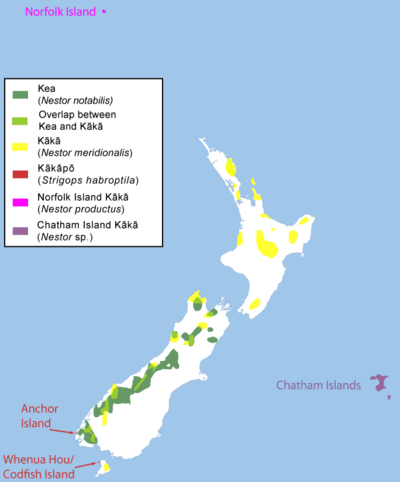New Zealand parrot facts for kids
Quick facts for kids New Zealand parrot |
|
|---|---|
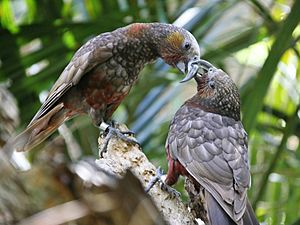 |
|
| New Zealand Kaka, North Island subspecies (Nestor meridionalis septentrionalis) at Auckland Zoo, New Zealand |
|
| Scientific classification | |
| Kingdom: | |
| Phylum: | |
| Class: | |
| Order: | |
| Superfamily: |
Strigopoidea
Bonaparte, 1849
|
| Families | |
The Strigopoidea are a small group of New Zealand parrots. They are also known as New Zealand parrots. This group includes three main types of parrots, called genera: Nestor, Strigops (the Kakapo), and an ancient fossil group called Nelepsittacus.
The Nestor group includes the clever Kea and the lively Kaka. The Strigops group has only one famous bird, the Kākāpō. All these living parrots are found only in New Zealand. This means they are endemic to New Zealand. The names Kea, Kākā, and Kākāpō come from the original Māori names.
Sadly, some parrots in this group have become extinct. The Norfolk Kaka and the Chatham Kaka, which lived on nearby islands, died out recently. Another group, Nelepsittacus, disappeared about 16 million years ago. Today, all the living New Zealand parrots are in danger.
Humans have caused these extinctions and the decline of the remaining species. Settlers brought new animals, called invasive species, like pigs and possums. These animals eat the eggs of birds that nest on the ground. Hunting, killing them as pests, and losing their homes (habitat loss) have also harmed these parrots. Even introduced wasps have added to their problems.
These parrots are very old. Their ancestors separated from other parrots about 82 million years ago. This happened when New Zealand broke away from a supercontinent called Gondwana. The ancestors of the Nestor and Strigops groups then split from each other between 60 and 80 million years ago.
Meet the New Zealand Parrots
This section describes the different types of New Zealand parrots. We know very little about the Chatham Kaka. The ancient Nelepsittacus group includes three known species and one yet-to-be-described species. Scientists found their remains in old rocks in Otago.
| Common name (scientific name) Status |
Image | Description | Where they live and their home |
|---|---|---|---|
| Nestoridae Family | |||
| Kea (Nestor notabilis) |
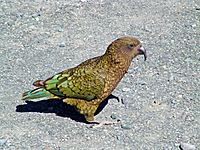 |
About 48 cm (19 in) long. Mostly olive-green with bright red under its wings and on its rump. Its feathers have dark edges. It has a dark brown beak, eyes, legs, and feet. Males have a longer beak. | New Zealand: South Island Lives in high forests and scrublands, usually between 850–1400 m (2,789–4,593 ft) above sea level. |
| South Island Kaka (Nestor meridionalis meridionalis) |
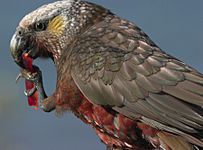 |
Looks like the North Island Kaka, but is a bit smaller and has brighter colors. Its head is almost white. Males have a longer, more curved beak. | New Zealand: South Island Lives in large areas of Nothofagus (beech) and Podocarpus (conifer) forests. In summer, 450–850 m (1,476–2,789 ft) above sea level. In winter, 0–550 m (0–1,804 ft). |
| North Island Kaka (Nestor meridionalis septentrionalis) |
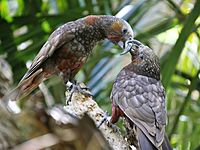 |
About 45 cm (18 in) long. Mainly olive-brown with dark feather edges. It has bright red under its wings, on its rump, and around its neck. Its cheeks are golden/brown, and its head is greyish. | New Zealand: North Island Lives in large areas of Nothofagus (beech) and Podocarpus (conifer) forests. In summer, 450–850 m (1,476–2,789 ft) above sea level. In winter, 0–550 m (0–1,804 ft). |
| Norfolk Kaka (Nestor productus) |
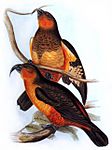 |
About 38 cm (15 in) long. Mostly olive-brown on its upper body. It had reddish-orange cheeks and throat, and a straw-colored chest. Its thighs, rump, and lower belly were dark orange. | Used to live only on Norfolk Island and nearby Phillip Island. Lived among rocks and trees. |
| Chatham Kaka (Nestor chathamensis) |
Appearance unknown, but bones show it could not fly well. | We only know about it from old bones found in the ground (subfossil bones). | Used to live only on Chatham Island of New Zealand. Lived in forests. |
| Strigopidae Family | |||
| Kakapo (Strigops habroptila) |
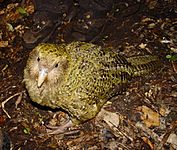 |
Large, round parrots, 58–64 cm (23–25 in) long. Males are bigger than females, weighing 2–4 kg (4.4–8.8 lb) when grown. Mostly green with brown and yellow spots. Their undersides are yellowish-green. Their face looks like an owl's. | New Zealand: Lives on Maud, Chalky, Codfish, and Anchor Islands. Lives in old Nothofagus (beech) and Podocarpus (conifer) forests. Also in regenerating scrublands and snow tussock grasslands, from 10–1400 m (33–4,593 ft) above sea level. |
Understanding Their Names
All the common names for these parrots are the same as their traditional Māori names. The Māori word kākā comes from an ancient Polynesian word for parrot. Kākāpō means "kākā of the night" or "night parrot." This name makes sense because the Kākāpō is active at night. In modern Māori writing, long vowel sounds like 'a' and 'o' are written with a line above them (like ā and ō).
The meaning of kea in Māori is not as clear. It might come from the sound the bird makes, like "kee-aah." This is called onomatopoeic.
Images for kids
-
Kea are very good at living in cold, high mountain areas, like these in the Southern Alps. New Zealand's highest mountain, Aoraki / Mount Cook, is in the background.
See also
 In Spanish: Strigopoidea para niños
In Spanish: Strigopoidea para niños


